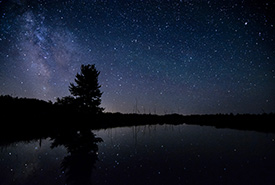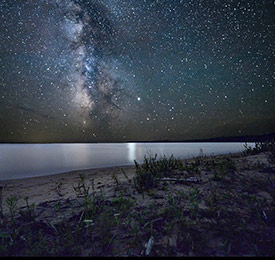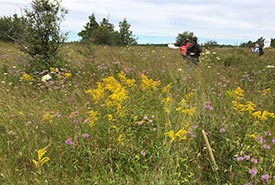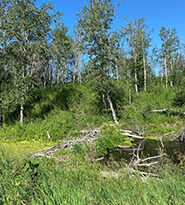NCC: Land Lines – Adventures in the night, continued!

The night sky over Rankin River in Saugeen Bruce Peninsula. (Photo by Esme Batten/NCC staff)
I get it. It can be hard to look outside in the winter and think, “Wow, I want to go and explore!” When it is -20 C and the wind is blowing, it’s hard enough to get outside during the day, never mind at night. However, I challenge you to do just that, because I promise you won’t regret it.
A few years ago, inspired by a few friends, I started taking photos of the night sky across the U.K, (see my blog here). Upon my return to Canada, I continued my astrophotography journey, and it has led me on some wonderful, although chilly, adventures.
Related content
Now don’t get me wrong, I almost never want to drag myself out of bed to hike along the edge of the Niagara Escarpment at 2 a.m., but I have never regretted it once I was out there. It is hard to find a similar sense of peace than being among the stars, where everything feels clearer. Perhaps everything else in my life feels small compared to where I sit in the galaxy, or that I get the opportunity to experience the forest in a way I don’t get to in the day. I am certainly lucky to live on the Saugeen Bruce Peninsula and have many incredible spaces in my backyard.
The Saugeen Bruce Peninsula has been designated a Dark Sky Preserve since 2004 and is a destination for stargazers, hikers and astrophotographers. During the summer, you get fantastic views of the Milky Way, and there are opportunities to get out with local experts to learn about the stars. In addition to being fantastic for star viewing, dark skies are also beneficial for wildlife.
Artificial lights can blind birds, causing them to fly into structures or become disoriented during migration. Mammals can become confused, changing their hunting and feeding habits, and plants can have their flowering and developmental patterns disrupted. Insects will also fly toward artificial light, where they are easy prey for birds and larger insects, which decreases the food available for other species, such as frogs, bats and small mammals. Dark Sky Preserves help protect the natural rhythm for wildlife.

The Milky Way photographed on Sand Bay at Cockburn Island. (Photo by Esme Batten/NCC staff)
I spend a lot of my time hiking around the Saugeen Bruce Peninsula, both for work and with my dog and friends during the daylight. After spending time in the U.K., although everywhere was familiar, everything also felt so different. I was seeing the area with a different perspective, looking at the landscapes in a way that I never had before. Now, every time I see a boulder on the shoreline or a dramatic view atop the escarpment that I had once admired as beautiful, I see the perfect foreground for an astrophotography shot.
Within a few months of being back in Canada, I had hiked to some of the most iconic places in the area — under the cover of darkness to capture them at night. Sometimes I would bring friends, but most often it was me and my dog, Luca.
Although some shoots work out really well, some don’t, as my friends Yvonne and Darci found out when they followed me around the base of the escarpment at midnight, searching for a trail in waist-deep snow. We eventually located it, but the stars were hiding behind a blanket of clouds for most of the night — not ideal conditions for photography. Despite about a third of my trips not working out as planned, I have never regretted a single night because they were chances to get out into nature and clear my mind.
I recently took a road trip across Canada with my cousin Amy and my friend Maddie. It wasn’t an astrophotography trip, but Amy and Maddie often joked about how often I commented on a particular landscape that would be amazing for photographing. One of our most memorable nights was spent in the Alberta badlands in Dinosaur Provincial Park. There were so many possible shots, and the peacefulness of it at night was such a contrast to the day time. I found myself laughing as I walked across the badlands, as the camera timer counted down, and I attempted to capture myself in an image.
Throughout the road trip, I found myself standing on the top of a mountain, coastal cliffs along the Great Lakes, and at the edge of waterfalls and vast prairies. I even had a chance to visit a Nature Conservancy of Canada property in Saskatchewan called Old Man on His Back Prairie and Heritage Conservation Area, which was designated as Canada’s first nocturnal sky preserve in 2015. The property is a 5,297-hectare (13,088-acre) ranch with a mix of grassland and native prairie. It has very little artificial lighting and provides habitat for roaming bison, ferruginous hawk, swift fox and burrowing owl. Regretfully, I was only able to visit for one night, but despite there being a full moon (which overpowers the stars), I enjoyed my experience on the property. I even saw one of the property’s roaming bison.
So, wherever you are, I challenge you to get outside and look up at the stars. It is a humbling experience, and you never know what you might see! There are some amazing resources to get you started, including a great video series by Welsh astrophotographer Alyn Wallace.
Check out some of my photos below:




